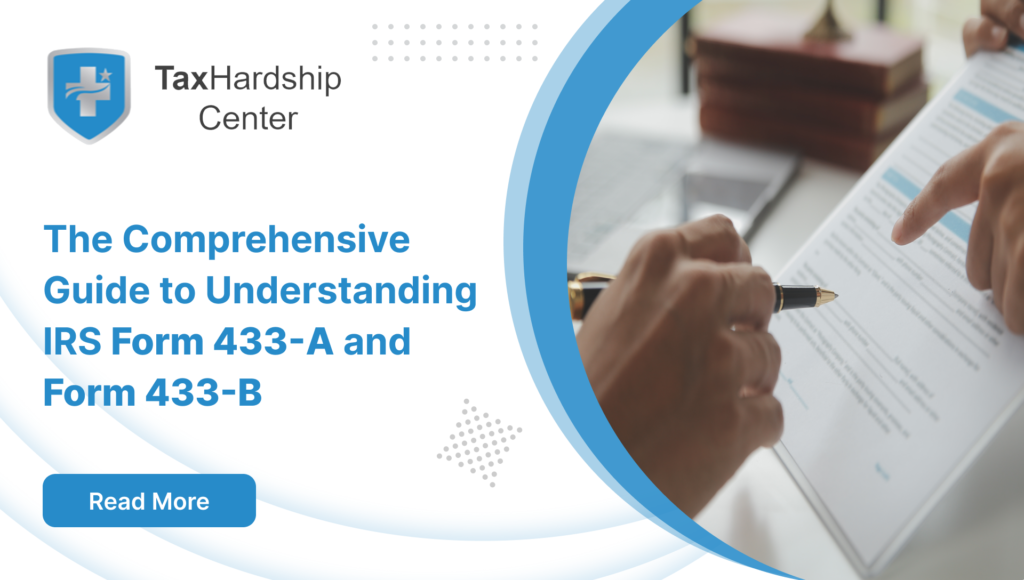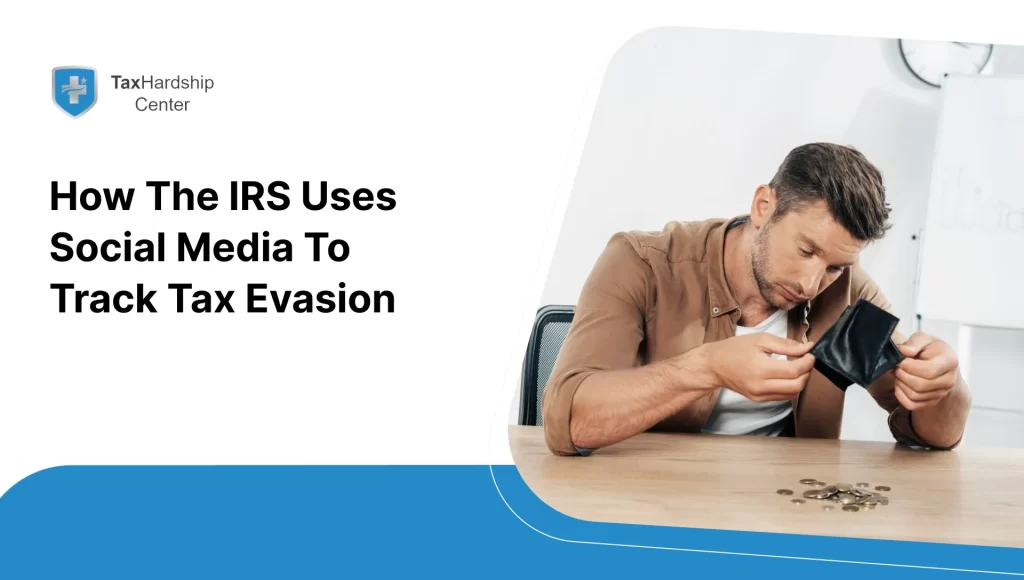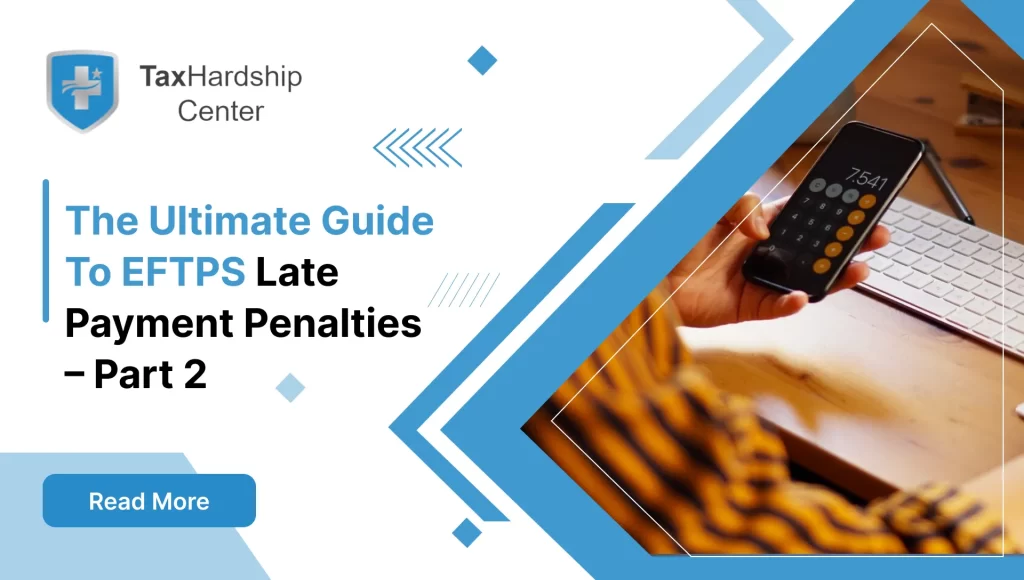Tax season can be challenging, particularly for self-employed individuals and small business owners who may owe back taxes to the IRS. Receiving an IRS notice can undoubtedly feel daunting. However, IRS Forms 433-A and 433-B are designed to help you navigate this process. When filled out accurately, these forms pave the way toward tax relief and manageable installment agreements.
This guide aims to simplify these forms and provide you with the necessary knowledge to tackle your tax obligations confidently. Together, we’ll turn these forms from hurdles into stepping stones towards easing your tax burden.
Basics of Form 433
IRS Forms 433-A and 433-B are comprehensive documents to gather precise details about taxpayers’ financial circumstances. These forms play a crucial role in assisting the IRS to devise strategies for collecting outstanding taxes. By providing a thorough snapshot of your financial status, these forms enable the IRS to make informed decisions. These decisions include granting you the option to pay your tax dues over some time through an installment agreement or determining your eligibility for other types of tax relief. Essentially, these forms serve as a bridge between taxpayers and the IRS, facilitating a smoother resolution of tax-related issues.
How Tax Hardship Center Assists with Tax Challenges
Tax Hardship Center specializes in assisting individuals and businesses facing tax challenges, specifically, those who can benefit from IRS Forms 433-A and 433-B. Our team is committed to understanding your unique circumstances and crafting personalized strategies using these forms to address your tax concerns effectively.
Whether you need a manageable payment plan (Form 433-A) or explore options to potentially reduce your tax debt with an offer in compromise (Form 433-B), we leverage our expertise in tax regulations to navigate these complexities. Our goal is to alleviate your financial burden and foster economic stability for the future. Trust Tax Hardship Center to guide you through the intricacies of Forms 433-A & 433-B and help you achieve a brighter financial future. Schedule a free consultation now.
What Is a Form 433-A?
Form 433-A is designed to assist individuals, specifically wage earners and self-employed individuals, in communicating their financial status to the IRS in a structured manner. This form is handy for those who cannot fully pay their income tax debt and seek a payment plan that fits their financial situation. Here’s a closer look at what the form includes:
- Personal Information: Taxpayers must provide personal identification details, including their name, social security number, and contact information.
- Income and Expenses: The IRS requires detailed information about the taxpayer’s monthly income and living expenses. This helps the IRS understand the taxpayer’s ability to pay.
- Asset Details: The form asks for a thorough account of the taxpayer’s assets, such as bank accounts, investments, and property, which could affect their ability to settle their tax debt.
- Business Information: For self-employed individuals, additional details about their business, including business type, account summaries, and assets, are necessary.
- Payment Plan Proposal: After analyzing their financial situation, taxpayers can propose a monthly installment amount they can afford to pay towards their tax debt.
Completing Form 433-A is crucial for taxpayers in negotiating a payment agreement with the IRS. The information provided must be accurate and complete to ensure that the IRS can offer a payment plan that is both fair and manageable, reflecting the taxpayer’s current financial reality. By diligently filling out this form, taxpayers demonstrate their willingness to cooperate with the IRS to resolve their tax obligations.
Understanding Form 433-A: Purpose and Usage
Form 433-A, officially titled the Collection Information Statement for Wage Earners and Self-Employed Individuals, is a pivotal document for individuals to provide the IRS with a full disclosure of their financial status. This form is particularly relevant for:
- Individual Taxpayers: It’s used by individuals who need to work out a payment plan with the IRS for their tax debts.
- Self-Employed: It’s crucial for self-employed individuals to detail their business income and expenses.
The form delves into:
- Income Streams: This requires detailed information about all sources of income, whether from wages, businesses, investments, or other means.
- Living Expenses: It covers all regular outgoings, such as housing, utilities, food, transportation, and healthcare.
- Asset Ownership includes all personal assets, such as bank accounts, real estate, vehicles, and life insurance.
- Debts and Liabilities: It encompasses all outstanding obligations, including loans, credit card debts, and other liabilities.
By completing Form 433-A thoroughly, individuals can help the IRS understand their financial situation. This enables the IRS to assess the kind of sustainable payment arrangement, ensuring that taxpayers can meet their tax obligations without undue hardship. It’s a critical step for individuals to take control of their tax situation and work towards a resolution that is both fair and manageable.
Who Needs to Complete a Form 433-A?
Form 433-A is an essential document that caters to individuals with specific financial circumstances. Here are some scenarios where Form 433-A becomes particularly relevant:
- Wage Earners, Self-Employed Individuals, and Independent Contractors: If you fall into any of these categories and have outstanding tax dues, you must familiarize yourself with Form 433-A. This form provides the IRS with a detailed snapshot of your financial situation, which aids them in determining an appropriate tax resolution strategy.
- Exploring Tax Relief Measures: Form 433-A is critical when considering options such as installment agreements or other tax relief measures to manage your tax obligations. By accurately completing this form, you can provide the IRS with the necessary information to evaluate your eligibility for these relief measures.
- IRS Request: The IRS may specifically request you to complete Form 433-A. In such cases, it’s crucial to comply promptly and accurately. Non-compliance or delays can lead to further penalties and stringent actions from the IRS, including wage garnishments.
Understanding and accurately completing Form 433-A is critical in navigating your tax responsibilities and securing a feasible payment plan. It allows you to effectively communicate your financial situation to the IRS, paving the way for a structured resolution of your tax liabilities.
What Is a Form 433-B?
Form 433-B is a critical document for businesses that cannot fully pay their tax dues. It is specifically designed for companies seeking to negotiate a payment plan with the IRS. Here’s what you need to know about Form 433-B:
- Purpose: The primary purpose of Form 433-B is to provide the IRS with comprehensive financial data about your business. This includes information on assets, liabilities, income, and expenses.
- Use in Installment Agreements: The IRS utilizes detailed financial information to assess the business’s ability to pay over time. This assessment is crucial in determining the terms of any installment agreement, which allows the company to pay off its tax debt in smaller, more manageable amounts.
- Required Documentation: Businesses must be prepared to submit extensive documentation when completing Form 433-B. This may include recent bank statements, profit and loss statements, and other records reflecting the company’s financial state.
- Accuracy and Honesty: It’s imperative to complete Form 433-B accurately and honestly. Any attempt to conceal assets or understate income can lead to significant penalties, including potential criminal charges.
By thoroughly and accurately completing Form 433-B, businesses can work with the IRS to find a viable path forward and avoid the severe consequences of unpaid taxes.
Understanding Form 433-B: Purpose and Usage
Form 433-B, the Collection Information Statement for Businesses, is essential for businesses navigating tax obligations. It’s a comprehensive form that requires detailed financial disclosures from various business structures, including corporations, partnerships, and LLCs. The form’s primary purpose is to provide the IRS with a clear picture of the business’s financial health, which is crucial for:
- Assessing Tax Liability: It helps the IRS determine the business’s ability to pay outstanding taxes.
- Creating Payment Plans: Based on the financial details provided, the IRS can work with the business to develop a feasible payment arrangement.
- Ensuring Fair Treatment: A thorough financial analysis ensures that businesses are treated fairly according to their ability to pay.
The form requires information on the following:
- Cash Flow: A snapshot of the business’s liquidity and cash reserves.
- Assets: Details on all business assets, including real estate, vehicles, and equipment.
- Credit Lines: Information on available credit and current borrowing.
- Payroll: Data on employee compensation and related expenses.
Completing Form 433-B is critical for businesses to manage their tax responsibilities effectively. It allows the IRS to consider the full scope of the business’s financial situation, leading to an equitable and manageable tax resolution. For businesses, it represents a proactive step towards resolving tax issues and ensuring compliance with tax laws.
Who Needs to Complete a Form 433-B?
Form 433-B is a crucial document that the IRS requires explicitly for businesses grappling with outstanding tax liabilities. This form becomes particularly significant in the following scenarios:
- Businesses with Tax Liabilities: Businesses with pending tax dues are the primary candidates for completing Form 433-B. This form provides the IRS with a comprehensive overview of the business’s financial situation, enabling them to devise an appropriate tax resolution plan.
- Financial Hardships: Business owners facing financial difficulties often need to seek structured tax relief solutions. In such cases, Form 433-B is a critical tool for communicating their economic status to the IRS.
- IRS Request: The IRS may specifically request certain businesses to complete Form 433-B. This is typically done when the IRS needs more detailed financial information from the company to assess its tax situation.
By understanding the need for Form 433-B and accurately completing it, businesses can take a significant step towards managing their tax obligations and seeking appropriate tax relief.
Essential Steps Before Completing the Form
Before you embark on the task of completing IRS Form 433-A or Form 433-B, there are several crucial steps you should undertake to ensure a smooth and accurate process:
- Gather All Necessary Financial Documents: This includes bank statements, pay stubs, property documents, and any other financial records that provide a comprehensive view of your financial situation. These documents will serve as the basis for the information you provide in the form.
- Review the Instructions for Each Form Thoroughly: The IRS provides specific instructions. It’s essential to read these instructions carefully to understand what information is required and how to fill out the form correctly.
- Consider Seeking Professional Tax Advice: Navigating tax forms can be complex. Professional tax advisors or IRS-sanctioned aid services can provide valuable guidance and help you avoid common pitfalls. They can also ensure you take full advantage of applicable tax relief measures.
- Verify All Information for Accuracy Before Submission: It’s crucial to double-check all the information you’ve entered in the form for accuracy. Any inaccuracies can lead to complications, delays, or even penalties.
- Keep Copies for Your Records: Once you’ve submitted the form, ensure you keep a copy for your records. This will be useful for future reference and for tracking the progress of your tax resolution process.
These steps ensure a more accurate and efficient process when completing your IRS Form 433-A.
Striking a Balance: Tradeoffs and Challenges
When completing IRS Forms 433-A and 433-B, it’s essential to balance transparency and affordability. The forms serve as a declaration of your financial health, and accuracy is paramount. Here’s why:
- Legal Implications: Understating your financial capacity may tempt fate with legal repercussions. It’s a risk that could lead to audits, penalties, or worse.
- Financial Overreach: Conversely, overshooting your financial capabilities could trap you in an overambitious payment plan, straining your resources.
The art of balancing involves:
- Cost Analysis: Scrutinize your budget. Identifying areas to trim without impacting your quality of life or business operations.
- Expense Reassessment: Re-evaluate your spending. Prioritize necessities and consider deferring less critical expenses to accommodate your tax obligations.
The goal is to present an honest yet sustainable financial overview to the IRS. This ensures that you can adhere to tax laws while maintaining financial stability. It’s about making informed decisions aligning with your legal responsibilities and personal or business sustainability.
The Impact of Decisions Around Form 433-A & 433-B
Your approach to these forms can significantly influence your tax relief options. A transparent and well-documented submission can lead to a manageable installment agreement, preventing further penalties and interest accruals on your outstanding tax debt.
The installment agreement itself is a double-edged sword. While it provides immediate relief by breaking down your tax debt into smaller, manageable payments, it also means committing to a long-term payment plan, which may require sustained financial discipline.
Conversely, not taking the forms seriously or delaying the submission can exacerbate your tax issues, leading to enforced collection actions by the IRS.
Conclusion:
IRS Forms 433-A and 433-B are crucial for individuals and businesses facing tax debts. These forms facilitate communication of financial status to the IRS, paving the way for manageable installment agreements. By completing them accurately and honestly, taxpayers can navigate their tax obligations effectively and work toward resolution.
Why Tax Hardship Center?
1. Hassle-Free Assistance:
Say goodbye to sleepless nights and endless tax-related stress. At the Tax Hardship Center, we believe in simplifying the complex. Our team of experts is dedicated to guiding you through every step of the process, ensuring that your tax concerns are met with precision and care.
2. 14-Day Money Back Guarantee:
We’re so confident in our ability to ease your tax worries that we offer a 14-day money-back guarantee. If, for any reason, you’re not satisfied with our service, we’ll gladly refund your investment. Your peace of mind is our top priority!
3. Free Consultation:
Are you curious about how we can transform your tax experience? Book a free consultation now! Our team will assess your situation, answer your questions, and provide free insights tailored to your needs.
4. Nationwide Coverage:
No matter which corner of the United States you call home, the Tax Hardship Center covers you. We proudly serve all 50 states, bringing our expertise to your doorstep. Wherever you are, our commitment to excellence follows.
FAQs:
1. Who needs to complete these forms?
Form 433-A is for individuals, while Form 433-B is for businesses with tax debts.
2. What information is required?
Both forms require detailed financial information, including income, expenses, assets, and liabilities.
3. What documentation is necessary?
Businesses must provide bank statements, profit/loss statements, and other financial records.
4. What are the consequences of inaccuracies?
Inaccuracies can lead to complications, delays, penalties, or legal repercussions.
5. Can professional tax advice help?
Yes, seeking professional advice ensures accurate completion and maximizes opportunities for relief.








